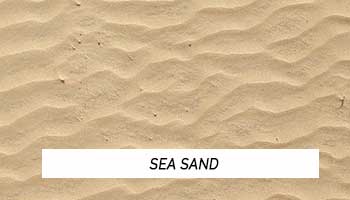Sand is one of the prior materials for Making Concrete. If the modular size of Fine Aggregate is less than 0.07 mm, then it is called Sand. So, it is used as a fine aggregate in mortar and concrete.
Sand is nothing but a granular form of Silica. The Sand used in Construction should be quartz (silicon dioxide), light grey or whitish variety and should be free from silt. The Fineness or Particle size of the sand should be in such a way that when the sand passed through 2-mm IS sieve, it should be retained fully on 90-micron IS sieve.
Types of Sand & Classifications:
Sand can be classified on various basis. They are as follows:
On the Basis of Mineral Composition: Depending upon the mineral composition, Sand can be classified into quartz, felspar and carbonaceous types
On the Basis of Particle Size: Depending upon the Particle Size of Sand, it can be divided into three.
If the Fineness Modulus (F.M) lies between 2.90 to 3.20, it is named as Coarse Sand
If the Fineness Modulus (F.M) lies between 2.60 to 2.90, it is called as Medium Sand
If the Fineness Modulus (F.M) lies between 2.20 to 2.60, it is defined as Fine Sand
On the Basis of Source: Depending upon the Source of Sand, it can be classified into three
Due to the natural disintegration of rocks or stream depositions, Natural Sand is formed.
By crushing the hard stones, Crushed Sand is Obtained.
By crushing the natural gravel, Crushed Gravel Sand is Produced.
On the Basis of Particle Size Distribution: Particle Size Distribution is nothing but the percentage of fine sand obtained when 100% sand passed through the various micron sieves. On the basis of the particle size distribution, they are divided into four, they are Grading Zone I, II, III and IV.
Types of Sand cannot be Categorised into a specific number as it is available in a number of forms on Earth. A few types can be listed based upon the market availability as below:
River Sand: It is clearly known from its name that it is the sand obtained from the banks of the river and river beds. This sand is found in the purest form as it is obtained from the running water and is round, fine, polished due to water friction. This is the best in all types of sand used in Construction works but especially recommended for Plastering works due to its naturally profound properties.

Sea Sand: It is obtained from Seashores. This sand is also fine, polished and round. It cannot be used directly in Construction as it contains salt which the weakens the strength of the mortar and delays setting time of cement. If this sand is free from salts, it can be used for all civil engineering works.

Pit Sand: These types of sand are extracted by digging up the earth soils. Granular size is bigger than the river sand, so it can be used for mortars

Filtered Sand: The sand obtained from the stagnated water. As the water is still for years which composes many physical and chemical impurities. The physical impurities of this sand are the silt, mud or clay. These physical impurities can be eliminated by washing and filtering. The chemical impurities which have unwanted chemicals cannot be removed and thus weakens the concrete strength, retarded cement setting time and lead to undesired reactions in mortars.

So, it can only be used as a filling, levelling material and can also be used as a bed material for underground plumbing works, pavers
M-Sand: M-Sand is nothing but Manufactured Sand or Artificial Sand. It is produced by crushing rocks and granite stones. It has almost similar properties of a River Sand. As the natural existed sand is depleting day by day and many not be obtained one day in the future, this sand can be replaced by Natural River Sand. Using this sand is eco-friendly and abundantly available in the market at budget-friendly prices when compared to river sand. M-Sand is also known as Robo Sand. It is one of the best types of sand used in construction.




